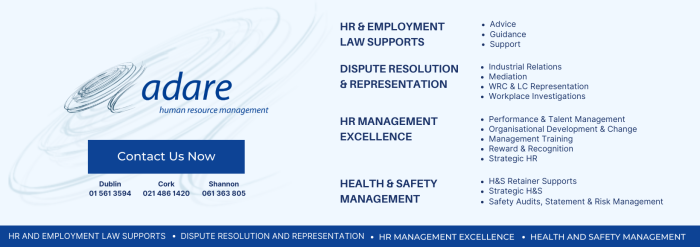
Key HR Metrics Every Business Should Measure
Key HR Metrics Every Business Should Measure All businesses can benefit from measuring key HR metrics. There are valuable insights to be learned from measuring key Employee data that can tell the real story of Employee experience in every Organisation. HR metrics provide critical data that can help management make informed decisions regarding workforce management, training needs, and resource allocation. By understanding trends and patterns within these metrics, businesses can identify areas of strength and pinpoint where improvements are needed. This article delves into just some of the key HR metrics that Organisations should measure today. Understanding these measurements is key to assessing the progress of a strategic approach to HR and ultimately the progress of business goals.
Employee Metrics
In the current tight labour market conditions, Organisations should be particularly focused on monitoring Employee retention and turnover. One question all Organisations have asked themselves is, “How do we keep top performers?” This is especially crucial right now, with the desire for good talent at an all-time high, and fierce competition for that limited talent pool. Some Employee turnovers may be desirable for your business and allow you to hire new talent and let the Organisation gain new skill sets.
– Employee retention
An Organisation’s retention rate measures its ability to retain Employees over a set period of time. When measuring Employee retention, new hires who came on during the specific time period are excluded. Likewise, recruits who are hired and leave within the relevant time period are excluded. If your Organisation is not retaining staff, action should be taken to find out why Employees are leaving.
– Employee turnover
Employee turnover is another metric that goes hand in hand with retention. Employee turnover calculates the percentage of Employees who join and leave a company over a period of time. A high turnover rate is costly, affects productivity, and makes it difficult to attract top talent. It can also indicate management or company culture problems.
Another useful metric to consider in this area is voluntary and involuntary turnover.
A voluntary turnover rate is the percentage of Employees who decide to leave a job for a variety of reasons, such as switching to another job or retiring. It is worth noting that these Employees tend to be more skilled and more expensive to replace.
An involuntary turnover rate captures the percentage of Employees who are dismissed, had contracts expired that were not renewed, or made redundant in a given period. A high involuntary turnover rate suggests that there are issues with job applicant quality and recruitment processes that need to be addressed.
A recent CIPD survey identified that the cost-of-living and housing crises are changing Employee behaviour and increasing Employee turnover. The survey recommends that Organisations implement pulse surveys to identify the profile of Employees at most risk of leaving (and the drivers of their behaviour), to review pay and benefits to ensure they are targeted at meeting Employees’ immediate needs. Adare Human Resource Management further recommends benchmarking your Organisation’s Employee turnover rates, pay, and other key HR Metrics against other Irish businesses to ensure you are competitive. The HR Barometer Survey conducted twice yearly provides up-to-date research on HR metrics across a variety of industries. This survey also includes detailed research on Employee health and well-being, Conflict and Dispute, Pay, Working Practices, and HR priorities in 2024.
START THE HR BAROMETER SURVEY NOW
By participating in the survey, you will receive free access to expert analysis of these critical areas, empowering you to benchmark your practices against those of other Irish businesses, and an invitation to our virtual event.
Absence Metrics
Identifying patterns and exploring underlying causes are key elements in effective absence management. Employee absence represents a significant cost to Organisations and, in order to mitigate this cost, Employers need to effectively record and manage absenteeism. A common formula to calculate absence rates is the total number of days lost to absence but measuring absence frequency can provide a better indicator of short-term absence levels and can help planning measures to address absence.
Other useful absence metrics to track are:
– Individual Frequency Rate
The individual frequency rate records the number of Employees who have been absent on sick leave on at least one occasion in the reference period.
– Average Duration of an Absence Period
A spell of absence is an unbroken period of time off, amounting to a day or a year, or more.
– Average Number of Spells of Absence per Employee
Identifying the number of spells of absence can help in identifying potential problem absence patterns where several short spells of absence may be occurring.
– Number of Days Lost per Employee
This measure can provide an Organisation with an overall view of the productivity loss caused by total absence in the Organisation. Coupled with some of the other metrics above, this measure provides a useful performance measure for an Organisation and can be used to track the overall impact of measures and strategies adopted to reduce absence rates.
Comparison of the Organisational sick leave absence rates against sector-specific external benchmark data can further assist in evaluating the relative level and significance of sick leave absence rates and/or provide a performance indicator for the Organisation to aim for.
– Absence Rate per Manager
It can also be worthwhile to break down absence rates per manager so Organisations can focus on problems that may be affecting specific teams.
A recent study by Cork University Business School found that Employee absences due to mental health difficulties have increased post-pandemic. The increasing prevalence of remote and hybrid working arrangements also poses mental health challenges associated with presenteeism. We know absenteeism can adversely impact business performance, it is important to identify the main causes of absenteeism in your Organisation and appropriate responses to deal with high levels of absenteeism.
Working Practices Metrics
When it comes to assessing remote or hybrid working arrangements, benchmarking can provide valuable insights into the effectiveness of your chosen model and where your Company stands in comparison to other businesses in Ireland. Key metrics to track might include the percentage of the workforce engaged in remote or hybrid working, and the average number of days Employees spend in the workplace. It is also important to consider the alignment of your Organisation’s remote working policies with upcoming codes of practice, such as the Right to Request Remote Working. Additionally, you should consider any initiatives your Organisation has implemented to support the success of its remote or blended working policy. Look at the data and metrics to see if the efforts are resulting in improved levels of Employee engagement and productivity.
Recruitment Metrics
Starting at the beginning of the employment relationship, there are a number of factors to consider to establish the effectiveness of recruitment activity. Organisations should carefully examine the following:
– The time it takes to fill a position
This will indicate if the recruitment process is efficient and effective. Screening procedures or interview processes may need to be reevaluated if it is taking too long to fill positions.
– The cost of filling a vacancy
Calculating cost per hire is done by adding up the Organisation’s recruitment costs and dividing this figure by the number of new hires. This figure will be influenced by the method of recruitment (agency v online advertising) and is a key metric to determine the correct allocation of resources in recruitment activity.
Employee Development Metrics
Finally, it is useful to measure how much time Employees take to earn a promotion or pay rise. High performing Employees will seek out a career development path and Organisations that do not deliver in this respect risk failing to engage or retain ambitious Employees. Organisations can measure the average time Employees take to earn promotions, pay rises or other career development milestones by adding up the time it takes Employees to reach a career development milestone and dividing the time by the number of Employees who succeeded in reaching a milestone. Depending on the outcome, it may be necessary to examine career development pathways and how to ensure talented Employees are engaged by long-term possibilities within your Organisation. Offering ongoing training and development to help Employees enhance their skills and advance their careers and fostering work-life balance are critical in attracting and retaining talent in the current tight labour market conditions.
Measure Your Organisation’s Performance Against Other Irish Businesses
As well as measuring your Organisation’s internal performance, it is also vital to benchmark your key HR metrics against up-to-date industry research.
Don’t miss out, Adare Human Resource Management HR Barometer Survey closes on March 22nd, 2024.
This is your chance to access detailed national benchmark research on HR metrics, Employee health and wellbeing, conflict, and disputes, pay, working practices, and HR priorities in 2024.
START THE HR BAROMETER SURVEY NOW
If you are developing or revising your Organisation’s collection of HR Metrics and need an experienced partner to set out a framework for success, please contact Adare Human Resource Management to learn what services are available to support your business.
Call (01) 561 3594 or email info@adarehrm.ie
Adare Human Resource Management is a team of expert-led Employment Law, Industrial Relations and best practice Human Resource Management consultants. If your Organisation needs advice, support, or guidance about compliance requirements or any HR issues. For more information, please visit our website www.adarehrm.ie

